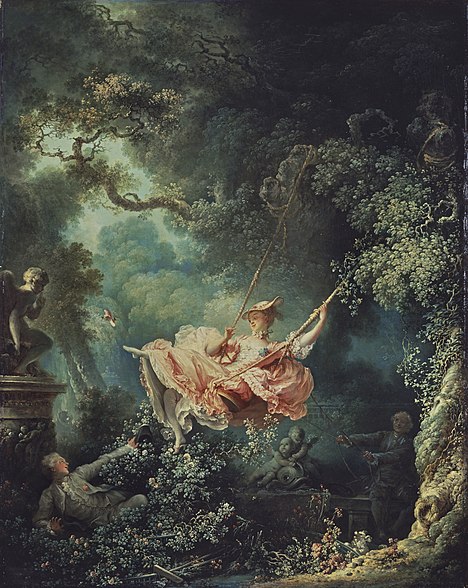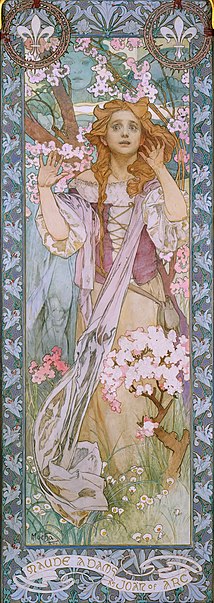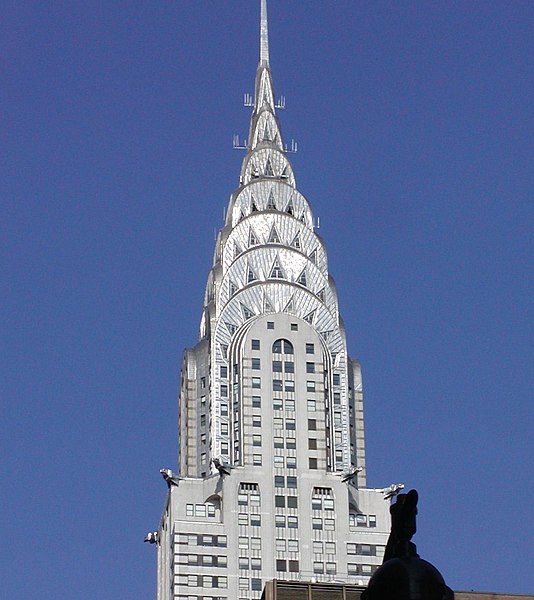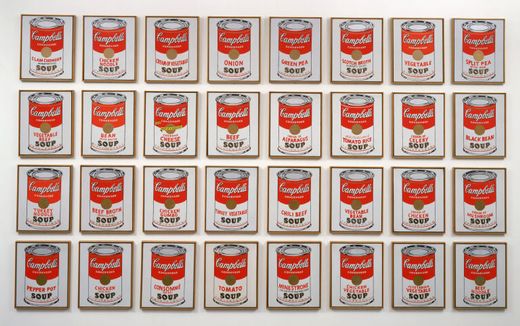The following are street trends from the twentieth century and its interpretation into high fashion:
1. Zoot Suits

August 1942, Los Angeles.

Characteristic of a Zoot Suit, watch chain.
Zoot Suits are characterized by several particular features. On trousers, they are wide-legged, tight-cuffed, pegged trousers with a high waist. On the coat, it consists of wide lapels and wide padded shoulders. The Zoot Suits were popularized in 1930s and 1940s by minorities group in the Los Angeles and Chicago areas and included African-Americans, Hispanics, and Filipinos. Accessories that occasionally accompany the Zoot Suit are: a felt hat with a pointy feather, french styled-shoes, and a watch chain.

Rachel Roy, Pre-Fall 2009 Collection
This suit has obvious inspirations from the Zoot Suit. It takes in the main components of the over-sized jacket and pegged trousers, but it also incorporates a feminine twist and modernity.

John Galliano, Spring 2002 RTW
This outfit emits a Zoot Suit feel with its wide shoulder and wide lapels, but mixes it up with a patterned prints, lining the bottom of the coat and cuffs of the sleeves and trousers, and a cinched waist.
2. Teddy Boys

Teddy Boys in the UK, circa 1953.

A group of Teddy Boys dancing at a rock n' roll show, 1973.
A fashion trend that started in the UK, it popularized Edwardian elegance over the New Look of the 1950s. The trend later made its way into America and became associated with American Rock n' Roll subculture. The term Teddy Boys came from a shortening of Edward to Teddy in a British newspaper. The style allowed for boys to dress for show. The outfit consisted of: a long, draped jacket, some with velvet trim; high-waist, drainpipe trousers; a loose neck, white collared shirt; and a brocade waistcoat. Some accessories often worn with the style were brightly colored socks and a bolo tie. A hairstyle also associated with the look was the Teddy Boy quiff.

Topshop Unique, Spring 2009 RTW
The influence of Teddy Boy fashion is seen in the jacket. The jacket is a long, draped style--a staple of the group--and has velvet trimming on the pockets, lapel, and sleeve cuffs.

Jens Laugesen, Fall 2008 RTW
The jacket on this ensemble is also long and draped, but it ties in the brocade that was fashionable on the waistcoat into the jacket.
3. Beatniks

Beat writers and artist having breakfast, late 1950s.

Movie: Beat Girl, 1953.
The Beatnik era came around the 1940s in San Francisco. The term "beat generation" was introduced in 1948 by Jack Kerouac to describe a time of spirituality. It combined the philosophy of anti-materialism and a time for soul-searching. The beatniks were often misrepresented and stereotyped. In fact, industries thrived off the concept. The style of the beatniks included: berets, leotards, sunglasses, baker boy hats, and ballet flats.

Miu Miu, Fall 2005 RTW
This outfit combines a monochromatic color scheme and minimalist shape for a version of the beatnik look. It is even topped off with a chunky, crocheted beret--a symbol almost synonymous with the beatniks.

Betsey Johnson, Fall 2008 RTW
The combination of a simple silhouette, pattern, and sunglasses make up a beatnik look. The stripes were a pattern choice favored by the beatniks because of its minimalism and helps to state the influence in this garment.
4. Mods

Mod icon, Model Twiggy, 1960s.

Music group: The Kinks. In Mod fashion.
Originating in England in the 1960s, the trend consisted of young adults that followed rock n' roll music. The mods were youths that did not have to contribute their income to family finances so instead spent it on trendy clothes. It was thought that the trend had ties to the beatnik culture and teddy boys. The look also blended a sort of pop art. For males the trend was expensive suits, and some males even wore make-up (e.g. lipstick and eye shadow). For females the trend was a more androgynous look with short haircuts and little makeup. Also the skirt line got shorter and shorter to push parental boundaries.

Roland Mouret, Spring 2004 RTW
This outfit captures the bright colors and a pop art feel popular during the mod era. It even combines the miniskirt into the overall effect.

Abaete, Fall 2007 RTW
With the tailored jacket and the short skirt line, this look joins together the trend for the mod males and females.
5. Hippies
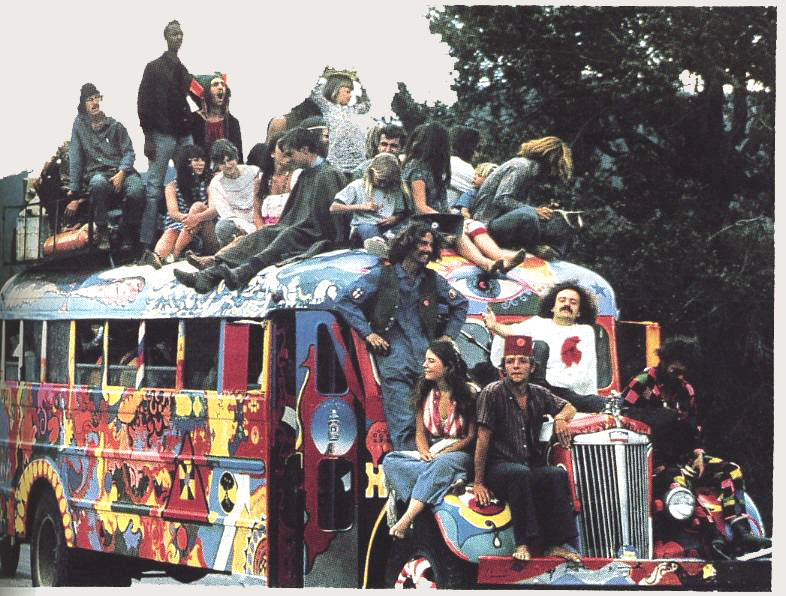
Hippies on a psychedelic bus, 1960s.

Hippies protesting the war, 1967.
This style began in the 1960s as a movement against war and establishment and had a start from the beatniks. The hippie partook in mind-altering drugs, listened to psychedelic rock, and believed in free love and a union with nature. Thus the lifestyle had a major effect on culture and is still is a way of life prominent today. The hippies belief in free love is reflected in their free-flowing form of dress. Also because of their challenge on gender differences, males and females were quite similar in dress. They both maintained long hair, wore jeans, and sandals. The hippie style also borrowed from Native American culture.

Y & Kei, Spring 2008 RTW
Y & Kei created an urban hippie look. The fringes are reminiscent of the Native American culture that the style borrows from. The free-form of the clothes helps to eliminate the gender differences that the hippies achieved with their original garbs.

Chloe, Spring 2008 RTW
This outfit echoes hippie fashion with its free-flowing fit and light-weight fabric.
6. Disco

Movie: Saturday Night Fever. Actor: John Travolta, 1977.

Movie: Skatetown, U.S.A., 1979.
Disco dress was directly influenced by Disco music. The time of disco introduced screening at the door--people began dressing to impress. The men dressed in three piece suits and the women in wrap dresses. Both sexes sported wide-legged, flared trouser and platform shoes. Also associated with this era were shiny and sequined fabrics. The clothes were fashioned from professional dance clothes hence the material related to it.

Rafael Lopez, Spring 2003 RTW
This outfit is a throwback to disco with its reinterpretation of the era's sequins and stretch fabric.

Tracy Reese, Spring 2008 RTW
Influences of disco are evident in the sequined blouse and the wide-legged, flared trousers. The outfit is able to reference disco without being dated.
7. Punk

Music group: The Ramones, 1970s.

Punk defying the main stream by burning a flag, early 1980s.
Punk is a look that came from the punk subculture. Punks were people that were alienated from the main social stream. They identified themselves through their clothes, jewelry, hairstyles, etc. Beginning in the 1970s, it has spun into many variations over time. T-shirts were a main staple of the trend and were worn intentionally torn. Popular items among punks were blazers, leather jackets, tight pants, and military boots. Women wanted to defy the notion of proper women and did so by pairing a symbol of feminism with a masculine item. Accessories associated with the trend were safety-pins, studded jewelry, fishnets, and eyeliner.

Luella, Fall 2009 RTW
Luella combined punk elements of: hair, boots, and studs to give this traditionally feminine attire more of a street feel.

Balmain, Fall 2008 RTW
This outfit mixes several pieces popular with the punk trend (i.e. tight, plaid pants; boots; and tank). It blends a feminine and masculine feel to achieve a look notable among female punks.
8. Hip Hop
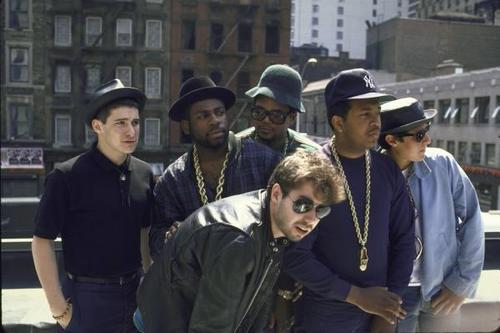
Music groups: Run DMC, in hip hop attire, with the Beastie Boys, 1987.

Music group: Retro Kids relive the 80s with their music and style, 2006.
Around the 1980s, hip hop fashion rose to the scene through music. The trend originating from low-income areas came from minority groups, mainly African-Americans and Latinos. When hip hop started, several sportswear associated themselves with the scene and has maintained themselves as symbols of the trend. Clothing prevalent at the time included track suits, bomber jackets, and sneakers. Accessories included multiple rings, nameplates, name belts, and heavy gold jewelry.

Alexander Wang, Fall 2007 RTW
Inspirations for this outfit came from 80s hip hip and 70s Parisian chic. Subtle hints of hip hop can be seen in the jacket and jewelry. The light tones of the 80s give this look a more modern appeal instead of an overbearing appearance.

VPL, Spring 2006 RTW
The look mimicked hip hop influences with its oversized skort and use of sportswear.
New Looks:
Times are quickly changing and with that so are the trends. Following are two new street trends.
1.Cowboy Chic

NYC gal sporting cowboy chic with straight leg jeans and cowboy boots. These paired with a class button-down shirt and a straw fedora, instead of an actual cowboy hat, gives it a modern look. 2007.

Man in Austin, Texas. A tailored jacket and hat complement the straight-legged jeans and cowboy boots. 2007.
This look brings together pieces associated with cowboys (i.e. cowboy hat, boots, straight leg jeans) and mixes them with modern pieces to give it a unique look.

Hermes, Spring 2008 RTW
This emulates cowboy with its color scheme and choice of material, but is brought to cowboy chic with it tailored jacket, dropped neckline, and accessories.

William Rast, Spring 2009 RTW
This outfit pairs fringed boots and a plaid shirt with torn skinny jeans and a leather vest giving it a very urban cowboy feel.
2. Grandpa Chic

Grandpa chic is achieved by pairing pieces of clothing similar to what your grandpa would wear. 2008.

Fok-Yan Leung sports grandpa chic with a wool sweater by Woolrich Woolen Mills (approx. $500). 2009.
People have been making references to boho looks and "old lady" looks, but there is also grandpa chic adopted by younger males. Quite similar to the old lady look in that it takes from styles of old men and spins it into a hipper look. Normally incorporating large cardigans and sweater vests. Spring 2010 is taking notice of the trend and it makes for a comfy, fashionable choice on the runway.

Ermenegildo Zegna, Spring 2010 RTW
The comfy grandpa sweater is combined with rolled up shorts and glasses to make this look chic. The color palette is more modern rather than using the normally bright hues associated with grandpa's clothes.

Missoni, Spring 2010 RTW
The oversized cardigan and fair isle-esque knit make for a grandpa look, but the twist is with the combination of the pieces that give the ensemble a youthful feel.
